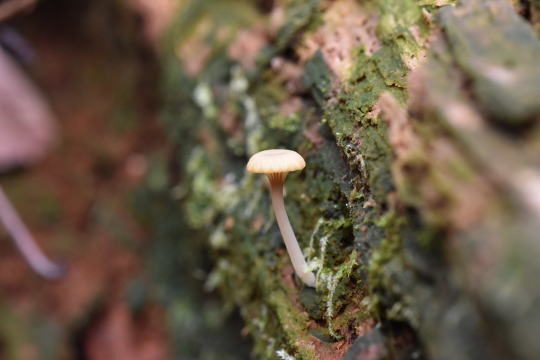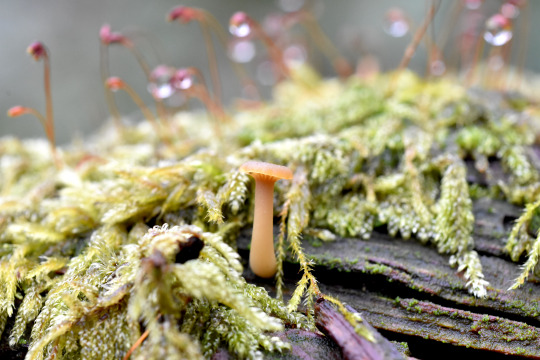Video
undefined
tumblr
Stentor roeselii, one of my favorite recent finds. Stentors make up one of the more recognizable families of ciliates, with their conspicuous trumpet form. Much like rotifers, they use a crown of cilia to wrangle in bacteria and algae to consume. While this stentor is clearly not connected to anything, usually the tip of their tail is fixed to a surface so that they can feed passively. As far as I know, the contraction near the end of the video is a defense mechanism, which they use rather frequently.
514 notes
·
View notes
Photo


This porous purple thing is technically an animal, which is kind of unsettling to consider. Sponges like Haliclona cinerea are only animals in the scientific sense; they have no nervous system, cannot move, and have no symmetry. They feed by filtering bacteria and other organisms out of the water that passes through them. Sponges form a basal taxon, and were some of the earliest organisms to evolve in the kingdom Animalia. Despite their distinct lack of personality, it seems like being a sponge has been a decent method of survival over the past half billion years as they’ve hardly changed.
#animal lover#nature photography#evolution#ocean#sea#seattle#macro#macrophotography#westcoast#pnw#outside#outdoors
194 notes
·
View notes
Photo

Sometimes the most beautiful flowers can be found in an overgrown field beside a drainage ditch
91 notes
·
View notes
Photo


Some species of spiders have developed a behavior of creating web decorations called stabilimenta, which were originally thought to help stabilize the web. Species like Argiope aurantia create an impressive zigzag platform to stand on, often appearing to float in the center of an otherwise inconspicuous web. There have been many reasons proposed for these decorations, the most likely of which is reflecting UV light to attract insects. This is not the reason that Occam's razor would likely pick, but the natural world is highly complex.
79 notes
·
View notes
Photo


I love all birds of prey, but I'll be damned if the Bald Eagle isn't one of the most majestic. I’m used to only seeing hawks and ospreys, and these eagles are comparatively enormous. These two have a regular nesting ground and seem to be preparing to make smaller eagles.
26 notes
·
View notes
Photo


Lichenomphalia umbellifera is one of the few lichens that produces stereotypical mushroom-shaped fruiting bodies. Like other basidiolichens, it developed the ability to commandeer photosynthetic organisms independently of typical ascomycete lichens. Basidiolichens are rare and exciting, making up less than 1% of lichenized fungi. In both photos, you can see a distinct green tinge on the log surrounding the mushrooms. This is part of the lichen, and is similar in function to a wide spread solar panel! The green color comes from chlorophyllous organisms (likely algae or cyanobacteria) entangled in fungal hyphal matter, allowing the fungus to acquire glucose.
83 notes
·
View notes
Photo



A fantastic cluster of pink mushrooms, likely Marasmiellus candidus. I am used to seeing them in a translucent white color, so these are a surprise. The spacing of the gills is quite aesthetic.
132 notes
·
View notes
Photo

Found this skittish friend, a wood thrush, near a salt marsh along the shore of Galveston Bay. Wood thrushes are rated Near Threatened by the International Union for Conservation of Nature, having declined in number by 50% since 1966 due to forest fragmentation across North America. Loss of habitat and urban sprawl are absolutely heartbreaking. Over the past few years, I have repeatedly seen my favorite patches of undisturbed wilderness bulldozed for roads, pipelines, and shopping centers. Nature isn’t some museum or a theme park for our leisure; it is a fundamental key to our survival. How can we best prevent habitat loss? I’d like to hear your opinions.
#environment#environmetalists#deforestation#global warming#nature photography#birds#urban sprawl#Texas#Ornithology#science
26 notes
·
View notes
Photo





The moments directly after a red-shouldered hawk (Buteo lineatus) jumped from its perch, displaying its eponymous red shoulders and characteristic planform.
170 notes
·
View notes
Video
undefined
tumblr
One of the most stunning creatures I’ve ever seen, a metallic wood-boring beetle (Chrysobothris sp.). Every time it spreads its elytra, it transforms from an insect into a rare gemstone.
98 notes
·
View notes
Photo



I made a beautiful new snake friend who let me get close and introduce myself. It is called a broad-banded water snake (Nerodia fasciata ssp. confluens) but also responds to “Richard” as far as I can tell. Since this species is nonvenomous, I stroked Richard’s tail. Richard was not fond of being touched and bashfully escaped to a hole in the ground. This got me thinking – where does a snake’s tail end? Is the entire snake a tail, with the exception of its head? Please let me know.
94 notes
·
View notes
Photo


The Vermilion Flycatcher, unable to read, carries on blissfully unaware of the existence of snakes. Meanwhile, snakes continue to exist.
724 notes
·
View notes
Photo


I was initially skeptical that this is an American green tree frog (Dryophytes cinereus), as it is entirely brown. However, it seems that these frogs can often change color based on the temperature or perhaps as a form of camouflage. The blood vessels in its gold-flecked eye are entrancing.
195 notes
·
View notes
Photo



Among the duckweed, this American Bullfrog seems almost complacent – confident in its camouflage and undisturbed by my attempts to edge closer. These frogs are enormous. As a result, they are known to eat bats and even small birds. If you ever have the pleasure to stumble upon one by accident, you may experience the initial terror of observing them fly out of the grass, well over your head, and into the nearest body of water.
59 notes
·
View notes
Photo






Psathyrella ammophila is one of the only mushrooms species that grows out of the sand. They are natively found in Europe, feeding on marram grasses that grow in coastal sand dunes. However, since European Marram Grass has been introduced invasively to the United States (including the Texas Gulf coast), I imagine Psathyrella ammophila was introduced as well. One of these also happened to have a cool “rosecomb” mutation that causes a section of the gills to grow out of the cap; a confluence of neat coincidences.
290 notes
·
View notes
Photo

Scolopax minor, the American woodcock, is a curious little bird that makes a strange sound like a small frog and performs an even stranger dance as it walks. I haven’t been able to photograph one until now, partially due to difficulty finding them, but also due to their tendency to flutter away dramatically when disturbed. The combination of their long, worm-seeking beaks and their enormous eyes make them both adorable and unsettling to watch.
61 notes
·
View notes
Photo

An immaculate Amanita (maybe Amanita fulva), growing out of its egg-like volva. Remnants of the volva are responsible for the patchy texture that you can often see on other Amanita species, such as the stereotypical red-with-white-spots fly agaric (Amanita muscaria).
42 notes
·
View notes